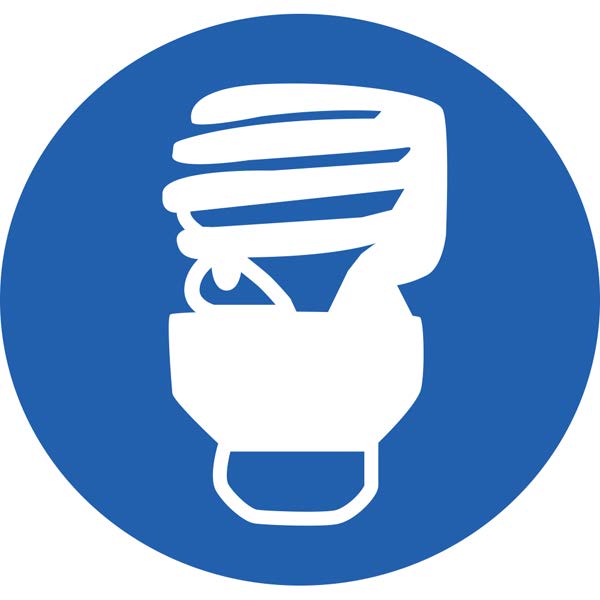Summary of Compact Fluorescent Light Bulb Handling and Disposal:
- CFL bulbs save energy over incandescents. To see your savings, visit the EPA Energy Star CFL calculator
- CFL bulbs contain a very small amount of mercury and should be recycled.

Unwanted CFLs may be accepted at the following locations:
- Home Depot
- Lowes
- All Household Hazardous Waste Collections
The Mercury Concern
Many items in a home, office or vehicle contain mercury. Pure mercury is a liquid metal, sometimes referred to as quicksilver, that evaporates easily. Mercury in the air eventually settles into water or onto land where it is eaten by fish and animals. It builds up over time and, most often, reaches humans through the food chain. Mercury can also be inhaled and absorbed through the skin, but this is not common. At high levels, mercury can cause harm to the brain, heart, kidneys, lungs and immune system. Young children and women who may become pregnant are warned against eating certain types of fish from various sources, such as Lake Michigan, due to the amount of mercury in the fish.
Mercury serves many useful purposes and has been used in products such as thermometers, switches, and various light bulbs for years. Recently, the energy efficient light bulbs known as compact fluorescent lights, or CFLs, placed a notification on the packaging alerting customers to properly dispose of the bulbs when they cease to function. This has caused an increase in the public awareness of mercury. There are other items that require proper disposal in homes that actually have more mercury in them than CFLs. Consider the following averages:
| Item |
Mercury Milligrams |
| CFL |
5 milligrams |
| 4’ Fluorescent Tube |
20 milligrams |
| Watch Battery |
25 milligrams |
| Glass Thermometer |
500 milligrams |
| Sump Pump Switch |
2,000 milligrams |
| Old Thermostat |
3,000 milligrams |
Making the choice to use CFLs is better for the environment and more economical. Burning an incandescent light that does not contain mercury can actually cause more mercury pollution due to the amount of extra energy required. A large portion of electric energy is generated by coal burning power plants. Since coal contains small amounts of mercury, burning it releases the mercury into the air. Use and recycle a CFL to release the least amount of mercury.
Broken Compact Fluorescent Light Clean-Up Instructions
- If a CFL breaks, the broken glass is probably the biggest concern. However, to keep mercury vapor exposure at a minimum, take these precautions:
- Keep children and pets away from the immediate area
- Open windows and ventilate the area for at least 15 minutes
- Put on disposable gloves
- Use duct tape or another adhesive material to pick up debris (scoop materials with a stiff sheet of paper or piece of cardboard if adhesive tape is not available)
- Clean the area with a damp paper towel
- Dispose of everything in a plastic bag
- Finish by placing the plastic bag of material in a second plastic bag and then placing that bag in an outside garbage container or bring it to a Household Hazardous Waste collection.
- NOTE: Do NOT use a vacuum, it may disperse mercury vapor & leave particles trapped inside the cleaner bag.
What happens to the CFLs?
CFLs contain glass, metal and mercury. When they are used, the mercury vaporizes and adheres to the glass. When they are spent or burnt-out, they need to be recycled to prevent mercury from escaping into the environment.
The CFL recycler uses special equipment to remove all the mercury from the glass and then recycles the metal, glass and mercury. The cost of processing the bulb is higher than the value of the materials. So government and businesses are currently paying for most of the CFL recycling collection programs.
Will County wishes to thank the businesses that are providing proper disposal for these highly efficient lighting devices.
(This page was Last updated 10-4-23)
©2010 Will County EEC. All Rights Reserved | Web site design and development by Americaneagle.com
|